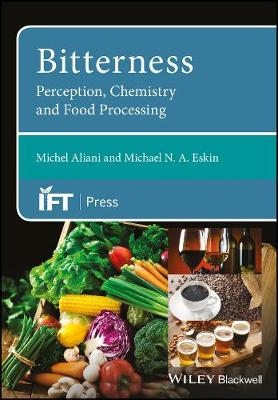
Bitterness
Wiley-Blackwell (Verlag)
978-1-118-59029-4 (ISBN)
The authors provide a thorough review of bitterness that includes an understanding of the genetics of bitterness perception and the molecular basis for individual differences in bitterness perception. This is followed by a detailed review of the chemical structure of bitter compounds in foods where bitterness may be considered to be a positive or negative attribute. To better understand bitterness in foods, separation and analytical techniques used to identify and characterize bitter compounds are also covered.
Food processing can itself generate compounds that are bitter, such as the Maillard reaction and lipid oxidation related products. Since bitterness is considered a negative attribute in many foods, the methods being used to remove and/mask it are also thoroughly discussed.
Michel Aliani is Associate Professor and Director of sensory research studies in the Human Nutritional Sciences department at the University of Manitoba, Canada. Dr. Aliani has expertise in flavor chemistry and mass spectrometry systems, and is interested in flavouromics, studies of functional foods which are destined to nutritional interventions and, in metabolomics, studies of biological fluids after ingestion of functional foods. Michael N. A. Eskin is Professor in the Department of Human Nutritional Sciences, Faculty of Agricultural and Food Sciences, University of Manitoba, Canada. Dr. Eskin has published over 120 research papers, 50 chapters and 13 books. He is the recipient of a number of awards, including the 2012 IFT Stephen S. Chang Award and the Alton S. Bailey Medal Award by the American Oil Chemists' Society for his research in lipids. In 2016, he received the Order of Canada for his pioneering research which contributed to the success of the Canadian canola industry. Dr. Eskin is also a fellow of IFT, The American Oil Chemists' Society, Canadian Institute of Food Science and Technology, and Institute of Food Science and Technology in the UK. He is a co-editor of Lipid Technology.
List of Contributors xiii
Preface xv
SECTION I THE BIOLOGY OF BITTERNESS PERCEPTION 1
1 Biochemistry of Human Bitter Taste Receptors 3
Jasbir Upadhyaya, Nisha Singh, Raj Bhullar, and Prashen Chelikani
1.1 Introduction 3
1.2 Bitter taste receptors: T2Rs 3
1.3 T2R signal transduction 5
1.4 Bitter taste perception and T2R polymorphisms 6
1.5 Ligand binding and activation mechanisms of T2Rs 8
1.6 Nutrigenomics of taste 10
1.7 Bitter taste blockers 12
1.8 Expression of T2Rs in extraoral tissues 12
1.9 Conclusion 13
Acknowledgement 14
References 14
2 Physiological Aspects of Bitterness 21
Maik Behrens and Wolfgang Meyerhof
2.1 Introduction 21
2.2 Anatomy 21
2.3 Taste signal transduction 23
2.4 Gustatory bitter taste receptor gene expression 24
2.5 Extragustatory bitter taste receptors 28
2.6 Outlook 31
Acknowledgements 31
References 31
3 Bitterness Perception in Humans: An Evolutionary Perspective 37
Hui Yang and Peng Shi
3.1 Bitter taste receptors - A group of G protein-coupled receptor (GPCR) members 38
3.2 Tas2R gene family - A highly diverse family in vertebrates 38
3.2.1 Bitter taste receptors - a group of G protein-coupled receptor (GPCR) members 38
3.3 The evolution of Tas2R gene family in vertebrates 40
3.4 Diverse selective forces drove the evolution of Tas2R genes in primates 41
3.5 Genetical basis of tasteblindness – human PTC perception as an example 43
3.6 PTC tasteblindness in humans and chimpanzees - shared phenotype resulted from unshared genotypes 44
3.7 Closing remarks 45
Acknowledgement 46
References 46
SECTION II THE CHEMISTRY OF BITTERNESS 49
4 Fruits and Vegetables 51
Ernst Hoehn and Daniel Baumgartner
4.1 Introduction 51
4.2 Fruits 56
4.2.1 Flavonoids, flavonols and limonoid aglycones in grapefruit, orange and lemons 56
4.2.2 Cyanogenic glycoside in apricot, almonds and other species 58
4.3 Vegetables 60
4.3.1 Brussels sprouts, cabbage, cauliflower, turnips/Swedes and collards and kale: glucosinolates/isothiocyanates and phenolics 60
4.3.2 Carrots: 6-Methoxymellein, polyacetylenes and phenolic acids 63
4.3.3 Potatoes, tomatoes and other solanum species: glycoalkaloids 66
4.4 Future progress 68
References 68
5 Bitterness in Beverages 81
Ayyappan A. Aachary and N. A. Michael Eskin
5.1 Introduction 81
5.2 Bitterness in tea 81
5.3 Bitterness in coffee 83
5.4 Bitterness in cocoa/hot chocolate 86
5.5 Bitterness in beer 87
5.6 Bitterness in wine 90
5.7 Bitterness in cider 92
References 94
6 Structural Characteristics of Food Protein-Derived Bitter Peptides 103
Rotimi E. Aluko
6.1 Introduction 103
6.2 Bitter peptides preparation and taste evaluation 107
6.3 Role of amino acid composition and position arrangement in determining peptide bitterness intensity 108
6.3.1 Relationship between peptide hydrophobicity and bitterness intensity 108
6.3.2 Influence of peptide chain length and N- or C-terminal amino acid residue 109
6.3.3 Amino acid type and position on peptide chain 111
6.3.4 Influence of amino acid isomeric configuration 117
6.4 Peptide Debittering Methods 117
6.4.1 Peptide complexation 117
6.4.2 Hydrophobic column adsorption 120
6.4.3 Enzyme treatment 121
6.5 Conclusions 123
Acknowledgement 123
References 123
SECTION III ANALYTICAL TECHNIQUES FOR SEPARATING AND CHARACTERIZING BITTER COMPOUNDS 129
7 Sensory Evaluation Techniques for Detecting and Quantifying Bitterness in Food and Beverages 131
Donna Ryland, Erin Goldberg, and Michel Aliani
7.1 Screening methods 131
7.2 Test methods 132
7.3 Techniques to maximize bitterness perception 137
7.4 Use of standards 138
7.5 Conclusion 139
References 153
8 Analysis of Bitterness Compounds by Mass Spectrometry 159
Geraldine Dowling
8.1 Introduction 159
8.2 Overview of LC-MS 163
8.2.1 Electrospray ionisation 163
8.2.2 Solvents 164
8.2.3 Additives 164
8.2.4 pH 165
8.2.5 Adduct formation 166
8.2.6 Ion-Pairing and ion exchange 166
8.3 Data acquisition in LC-MS 167
8.3.1 Targeted compound screening 167
8.3.2 Non-targeted compound (retrospective) screening 167
8.3.3 Ion annotation 169
8.3.4 Mass-based identification 169
8.3.5 Spectral interpretation 170
8.3.6 Spectral matching 170
8.3.7 Compound identification 171
8.4 LC-MS application of bitterness compounds 172
8.4.1 Bitter compound quantitation by triple quadrupole and selected ion monitoring 172
8.4.2 Quantitation of bitter compounds by LC-IT-MS and LC-HRMS 175
8.5 Challenges and future perspectives 178
8.6 Optimisation of mass spectra parameters 179
8.7 Recording of MSn profile 179
8.8 Challenges in the collection of HRMS data 183
8.9 Conclusions 185
References 186
9 Evaluation of Bitterness by the Electronic Tongue: Correlation between Sensory Tests and Instrumental Methods 193
Michel Aliani, Ala’a Eideh, Fatemeh Ramezani Kapourchali, Rehab Alharbi, and Ronak Fahmi
9.1 Introduction 193
9.2 The electronic tongue 193
9.2.1 Sensor arrays 194
9.2.2 Data processing 195
9.3 The electronic tongue and food production 195
9.4 Electronic tongue and bitterness 197
9.5 Evaluating bitterness in food products using electronic tongues 198
9.6 Conclusion 202
References 202
SECTION IV METHODS FOR REMOVING BITTERNESS IN FUNCTIONAL FOODS AND NUTRACEUTICALS 207
10 Methods for Removing Bitterness in Functional Foods and Nutraceuticals 209
Erin Goldberg, Jennifer Grant, Michel Aliani, and Michael Eskin
10.1 Introduction 209
10.2 Reducing and removing bitter components 210
10.2.1 Physical methods 210
10.2.1.1 Temperature treatment 210
10.2.1.2 Ion exchange and adsorbent resins 222
10.2.1.3 Extraction with sub-critical water 222
10.2.2 Chemical methods 222
10.2.2.1 Fermentation 222
10.2.2.2 Aging and polymerization of phenols 223
10.2.2.3 Alkalization 223
10.2.3 Masking techniques 224
10.2.3.1 Flavorings 224
10.2.3.2 Amino acids 226
10.2.3.3 Aroma additions 226
10.2.3.4 Gluconate and acetate 228
10.2.3.5 Lipids: phospholipids and fatty acids 228
10.2.3.6 Zinc, lactate, and acetate 228
10.2.4 Bitter blockers 229
10.3 Conclusion 231
References 232
Index 237
| Erscheinungsdatum | 09.04.2017 |
|---|---|
| Reihe/Serie | Institute of Food Technologists Series |
| Verlagsort | Hoboken |
| Sprache | englisch |
| Maße | 170 x 246 mm |
| Gewicht | 703 g |
| Themenwelt | Sachbuch/Ratgeber ► Gesundheit / Leben / Psychologie ► Ernährung / Diät / Fasten |
| Naturwissenschaften ► Chemie | |
| Technik ► Lebensmitteltechnologie | |
| ISBN-10 | 1-118-59029-5 / 1118590295 |
| ISBN-13 | 978-1-118-59029-4 / 9781118590294 |
| Zustand | Neuware |
| Haben Sie eine Frage zum Produkt? |
aus dem Bereich


